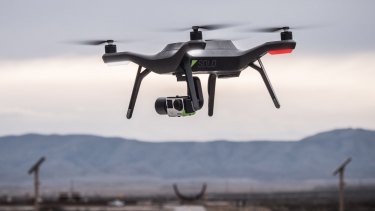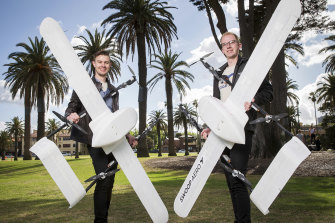The situation in Logan is a good example of how community anxiety about the use of drones can be allayed over time and the pandemic has ended up reinforcing the usefulness of drones across a range of sectors, from delivery of goods and 3D mapping.
Loading
Jonathan Bass, head of Wing, which is owned by Google’s parent company Alphabet, says orders worldwide for the drone delivery company’s services have increased about five times since the beginning of the COVID-19 pandemic and he expects the boost to be permanent.
“It’s great for people that might not be comfortable leaving their homes for any reason, outside of the pandemic situation,” he says. “It’s also very helpful for people that have young children and may not be able to run out to the shops or somebody who may be working from home on a given day.”
Wing is operating pilot programs in Logan and in Canberra, and has plans to expand its services into other locations in Australia.
“We started very early in Australia I think Australians are are generally keen on drones and keen on new technologies,” he says.
Wing faced some community opposition to its trials in Canberra from residents concerned about the noise and the impact on wildlife but Bass says redesigning the drones’ propellers to make them quieter has resolved most of these concerns.
“Since we made that change the feedback that we’ve received on noise has been dramatically more positive and that was definitely a big lesson for us from that trial,” he says.
Wing won’t reveal how much it is investing in the trials which enable businesses to use its drones to deliver items. However, other startups have already started making a commercial return from the technology.
Aeromedical logistics startup Swoop Aero, launched in 2017, is using drones to deliver medical supplies in Malawi, the Democratic Republic of Congo and Mozambique. The startup raised an “eight figure sum” from investors including Right Click Capital and Tempus Partners in June.
Chief executive and co-founder Eric Peck says the company, with a team of around 40 people, has been able to compete with giants like Google by being quick to market with its service.
Swoop Aero chief executive Eric Peck, and chief technology officer Josh Tepper.Credit:Paul Jeffers
“We’re still a small nimble company and that gives us a lot of flexibility to be able to respond to market demands,” he says. “One thing we learned very early on is that just by getting into the market and working alongside of real paying customers you can really quickly learn.”
Swoop has also seen an significant uptake in demand as the coronavirus pandemic started to spread across the globe.
“When the networks were up and running it became a very logical choice to be able to deploy effectively small aircraft to fly over the top and move products between different areas in different regions,” he says. “It’s a contactless supply chain to move medical products around without having to have people go to and from little villages and have the dangers of transmission.”
Peck believes this increased demand will continue post-pandemic.
“It has really highlighted the need for continued and ongoing investment into public health,” he says. “Having a supply chain that is able to respond to a very dynamic situation like the one we face is going to be something that health systems across the world are willing to invest in into the future.”
Peck says Swoop’s operations in Australia and New Zealand are “about to start imminently” and now make commercial sense.
However, he adds the true inflection point for drone technology locally will come when there is a single, comprehensive regulatory system for the drone businesses to follow, instead of different regulations in different states and jurisdictions. Community perception of drones also needs to improve.
“We’ve noticed that people already have a lot of negative experiences with drones,” he says. “I think when those two things come together, that we can build community trust in the technology, it’s not just trying to spy on you.”
Niki Scevak, partner at venture capital firm Blackbird Ventures, believes the use of drones by businesses will really come into its own when drones can autonomously pilot themselves.
“The key inflection point is at the moment you need a human set of eyes piloting a drone they are reliable and cheap but you still need a human operating,” he says. “Artificial intelligence when a drone can autonomously pilot itself, even to the extent of one person piloting eight at a time, that is when the use cases will really explode. At the moment one set of eyes is expensive.”

Drones may one day be an answer to the problem of having enough carers for an ageing population.
Blackbird is an investor in surveying data analytics and 3D mapping startup Propeller Aero which raised $26 million in July this year.
Propeller Aero’s drone mapping technology is used by mining, quarry and construction companies to create 3D maps of their worksites.
“Propeller is one of the fastest growing companies in our portfolio, like Safety Culture and Canva it will be that kind of iconic company in a couple of years,” Scevak says.
However Scevak says Propeller is now moving beyond drones to its new product DirtMate, which will make maps in real time using Internet of Things sensors on machinery.
“We are still probably a couple of years away from that point of time that is when you will see every pizza and burrito delivered by drone,” Scevak says.
Technology Newsletter
The top technology stories and reviews delivered weekly. Sign up to The Age‘s newsletter here and The Sydney Morning Herald‘s here.
Cara is the small business editor for The Age and The Sydney Morning Herald based in Melbourne
Most Viewed in Business
Loading
 Unmanned Aerial Vehicle The latest drone news
Unmanned Aerial Vehicle The latest drone news




